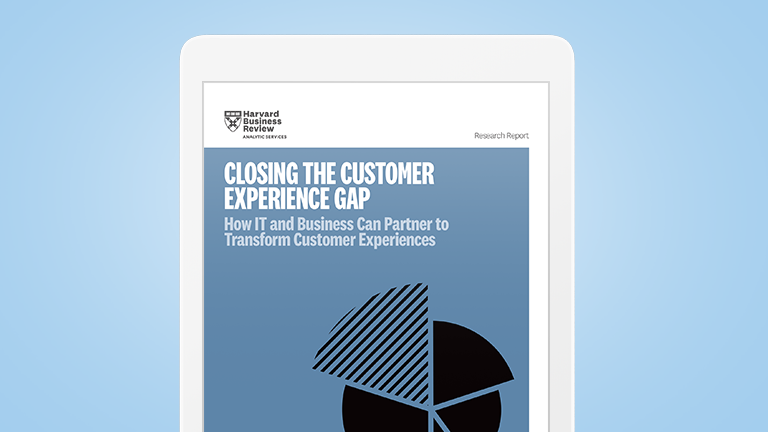Closing the Customer Experience Gap


Analytic Services Research Report
There is broad agreement in the executive and management ranks that customer experience is a key competitive differentiator today. Companies of all sizes and across all industries see the strategic significance of superior customer experience expanding in the future. Nearly three-quarters of business leaders (73%) said that delivering a relevant and reliable customer experience is critical to their company’s overall business performance today, and almost all (93%) agreed that it would be two years from now.
However, very few companies have the necessary technology systems in place to support the organizational and process changes required to reorient the business to the customer. Delivering a superior customer experience requires flexible software capable of ingesting and analyzing growing volumes of data in various forms, and legacy systems are rarely capable of this task. As a result, there is a substantial disconnect between the importance of customer experiences and the capabilities of companies to deliver them. A mere 15% of business leaders rated their customer service strategy and approach as very effective, while just over half (53%) said their approach is somewhat effective.
These are among the findings of a new Harvard Business Review Analytic Services study of 680 executives about customer experience management—research that features in-depth interviews with several top-performing company leaders.
Increasingly, customer experience is the competitive differentiator as companies battle for business in industries where products are growing ever more commoditized and customers significantly more demanding—and IT is uniquely positioned to lead the technology, process, and organizational transformation required to meet customers where they are. “We must continuously improve our customer experience by, for example, removing friction from our processes and adding new features to our products,” said the customer experience leader at an international financial services company in the midst of a global reorganization to improve customer experience performance. “We need to make sure that our customers have an optimal experience across various silos and products from start to finish.”
Data has a clear role to play in developing a superior customer experience— and companies have access to more information on their customers than ever before. Indeed, they are seeing an exponential increase in customer-related data, driven largely by social media, mobile, and e-commerce. But these expanding troves of customer information alone are clearly not driving customer experience improvements—let alone innovation—in the vast majority of organizations.
Three-quarters of companies are not able to act on the majority of data they collect, owing in large part to disjointed systems and data integration issues.
Organizational silos, lack of funding, cultural resistance, and availability of skills are preventing most companies from creating a single source of customer intelligence available throughout the enterprise—long the Holy Grail for customer experience improvement. IT leaders can play a critical role in breaking down the organizational and technology silos holding customer data hostage and working with experienced vendors and consultants with the data and analytics capabilities and next generation technologies required to build a robust foundation for customer experience in the future. They must also work in partnership with customer experience leaders to tackle the larger strategic issues holding companies back.
Organizations must have explicit executive buy-in, and their leaders need to develop, communicate, and execute a clear and cohesive customer experience strategy. The structural, technological, and process reengineering required in order to deliver a single customer view is easier to deliver when the appropriate customer values, incentives, and direction are in place. Those companies with leaders that have not bought into the value of an integrated and all encompassing customer experience foundation find their efforts lack the clarity, budgetary support, and organizational structures to drive customer-focused transformation.
“The good new is that the corporate leaders agree about what it will take to digitally transform their organizations around the customer.”
The Keys to Customer Experience Transformation
“Customer experience has to be a priority, but more than that, it has to be built into the organizational culture, or it can be set aside when other priorities emerge,” said the president and CEO of a U.S.-based credit union, noting that it is something that both employees and business partners must espouse and bring to life every day. “Customer experience is something we have to focus on all the time to make sure that we never let it slip, because we always have new employees, new systems, new vendor relationships. The customer experience has to transcend all of that as a key focus.”
Well over 80 percent of respondents also said that having management and leadership buy-in, visibility into and understanding of the end-customer experience, and a clearly communicated customer experience strategy were critical components of delivering a winning customer experience. Yet less than half of them rated their companies’ performance in any of these areas as very effective.
But what companies are really struggling with is customer data and the technology foundation required to make sense of it all and distribute the resulting insight throughout the organization. Data and systems integration and visibility across the enterprise, giving employees the power to deliver and innovate around customer experience, and aligning IT decision-making with customer experience demands were all cited as extremely important in delivering a superior customer experience. Yet only around a quarter of respondents said their companies perform well in these areas.
The chief customer officer (CCO) at a multibillion-dollar institutional investment and benefits provider is beginning to address some of these issues by breaking down barriers between customer experience and IT strategy and execution. “We realized we weren’t moving fast enough, so our CIO handed 36 of his technologists to me,” said the CCO. “You can’t get meaningful customer work done if there are functional lines getting in the way. So we have arranged ourselves entirely around the customer under one structure. We make all the decisions—and we’re on the hook for the outcomes.”
Having senior leaders define ideal customer experiences and translate those into a well-thought-out strategy is also key. Ideally, executives convert these intended outcomes into a “detailed and prioritized customer experience initiative road map that incorporates a well-thought-out data strategy, integration of databases, and tools to provide a single view of the customer, the means of delivering the right intelligence to the frontline employees to manage customers’ experiences, and staff training,” said the senior vice president of strategic analytics for a marketing services firm. “When such an exercise hasn’t taken place, customer experience is only a ‘temperature-checking’ exercise without the ability to quantify how improvements in key engagement areas translate into improving customer experience and connecting those gains to economic results.”
Creating a customer-focused culture is easier in some industries than others. The head of process and technology innovation for a software development company—an industry not known for satisfied customers—said creating a customer-centric culture takes a targeted effort. “One of our challenges is bringing customer centricity into all levels of the organization. Most of our organization is made up of engineers; understanding customers is not something they are taught,” he said. “When we hire someone, we spend a great deal of time and money to get them to the place where they understand what is important [to the customer]. Once you have a customercentric culture in place, it’s easier. That’s a much more powerful tool than just training.”
Closing the Customer Experience Gap
overview
Chapter 1
Chapter 2
Chapter 3
Chapter 4
Want to read the full report?
Questions? We’ll put you on the right path.





